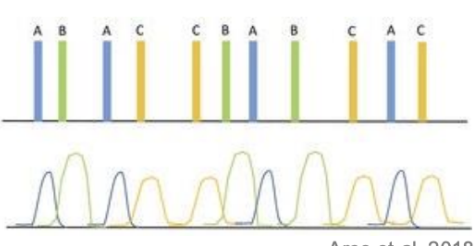fMRI Experiments
1/14
There's no tags or description
Looks like no tags are added yet.
Name | Mastery | Learn | Test | Matching | Spaced |
|---|
No study sessions yet.
15 Terms
Primacy of Action Argument
View that the the brain evolved primarily to produce and control movement (Simply moving increases an organism’s chances of survival)
⚠ Problem: Most standard fMRI experiments lack behavioral components → Push for incorporating behavioral tracking.
Task-Based Paradigm
Paradigm where participants perform specific tasks or are exposed to controlled stimuli while brain activity is measured. These tasks are designed to isolate and investigate brain activity associated with assumed cognitive processes.
Block Design
Design where stimuli are presented in alternating blocks of conditions. Each block lasts for a fixed duration, ensuring sustained neural activation.
+ High statistical power (strong BOLD + independent time points)
+ Easy to analyse (Clear separation of conditions)
- Limited research questions
- Unrealistic (Low ecological validity)
- Habituation effects

Event-Related Design
Design where stimuli are presented as individual events at unpredictable or varying time points, rather than in continuous blocks. With this design, participant has power over when things happen (stimulus control).
+ Broad range of research questions
+ Self-paced tasks
+ Trial-by-trial variability leads to less habituation
- Low statistical power
- Overlapping brain activity complicates interpretation
- Requires sophisticated timing and analysis + more data

Behavioural Response Tools
Button Box/Joystick (Tracks participants responses via physical input)
Eye tracking (Measures where participants are looking (attention) and tracks pupil dilation (arousal))
Microphones (Captures verbal responses or spontaneous speech during fMRI tasks)
Pneumographic Belts (Tracks respiratory changes linked to emotional or cognitive states)
Pulse Oximeter (Monitors physiological arousal and stress trough blood oxygenation and heart rate levels)
Stimulus Presentation Tools
Screen + Monitor (Uses a projector or screen viewed through a mirror attached to the head coil)
Googles + Headphones (Delivers immersive visual and auditory stimuli, including virtual reality (VR) and binaural audio experiences)
Vibration Devices (Provides physical stimulation to simulate touch)
Galvanic Stimulator (Stimulates the inner ear via electrical currents or cooling to induce artificial sensations of movement or balance shifts)
Gustometers + Odor Stimulators (Delivers controlled taste and scent stimuli via specialized dispensers)
Brain Stimulation (Uses Transcranial Magnetic Stimulation (TMS) or MRI-compatible electrical stimulation to modulate neural activity in targeted brain regions)
Experimental Control
+ Clearer result interpretation (factor A explains results not B)
+ Many simple feasible experiments and analyses
+ Easier to standardise and replicate
+ Analysis assumptions met through task design
- Constrained and artificial conditions
- Results might not generalise to real world (low ecological validity)
- Solid interpretations require many controls
- Full control of behaviour is neither feasible nor desirable for understanding the brain
Naturalistic Conditions
+ Closer to real life (high ecological validity) with better generalisability of results
+ Interactions between factors can be studied
+ Discovery of unexpected phenomena more likely
+ Many engaging experiments
+ Measuring rather than controlling behaviour
- Results are more difficult to interpretation (Overlap of brain activity/data)
- Invites unconstrained data exploration
- Analytical challenges (e.g. collinearity (hard to tease apart), missing data)
- MRI experiments limited in terms of naturalistic (MRI is MRI)
Resting State Paradigm
Paradigm where participants lie in the scanner and rest (normally fixate on a dot) while brain activity is recorded. The goal is to study intrinsic brain activity and functional connectivity - how different brain regions coactivate over time without external stimulation.
🔔 Reminder: Always include behavioural tracking, even during rest (The role of behaviour in cognition is hard to estimate a priori e.g. gaze reinstatement)
+ Easy to perform (no instructions needed for medical staff)
+ Widely applicable in special populations (e.g. patients, elderly, children)
+ Task-evoked responses often explain shockingly little variance (less than 5% of signal)
+ Fertile ground for the development of data-driven analysis tools
- No control or measurement of what participant experience or do
- Often difficult to interpret
- Imaging artefacts (e.g. motion) strongly affect connectivity results
- Functional connectivity does NOT reflect anatomical connectivity
- Resting state results are not very predictive of behaviour
Default Mode Network
Core brain network that is more active during rest than during tasks. It shows increased activation during rest and deactivation during cognitive tasks suggesting that it is the brain’s default state.
Functional Connectivity
Common way of making sense of rs-fMRI data by measuring the covariation of activity between multiple different voxels (Looks at whether certain areas show synchronised fluctuations in activity over time).
❗Note: Functional connectivity (Measures correlated activity between regions) ≠ Anatomical connectivity (Actual white matter pathways)
Two regions can be functionally connected even without direct anatomical connections! (💡 monkey brain severed anatomical connection but functional connectivity remained the same)
Seed-Based Functional Connectivity
Functional connectivity measure where a ‘seed’ area (voxels in specific brain region) is selected and correlated with all other voxels in the brain to identify ‘functionally connected’ regions. (Network level perspective)
Parcellation
Divides the brain into regions based on how voxels are functionally connected to the rest of the brain - their connectivity fingerprints.
Integrated Paradigm
Paradigm that combines aspects of both task-based and resting-state paradigms to examine brain activity in more complex or naturalistic settings. These paradigms aim to balance experimental control (from tasks) with realistic cognitive processes (from resting-state or naturalistic conditions).
Inter-Subject Correlation (ISC)
Statistical method that correlates voxel time courses across participants experiencing the same stimulus to assess how BOLD signals covary between them. In contrast to functional connectivity ISC reveals brain activity that is shared across people, illuminating general principles.